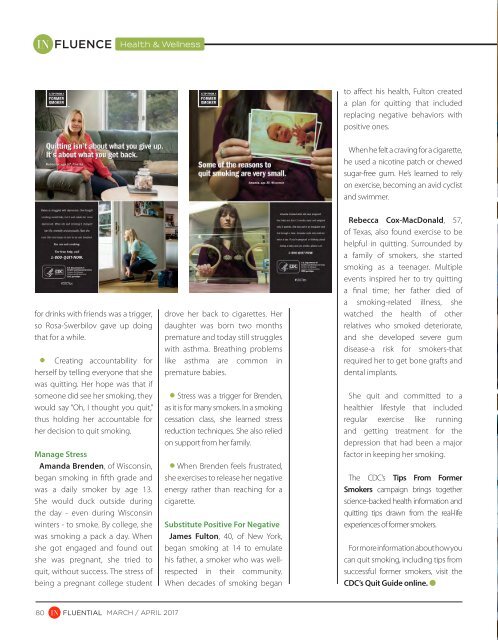InFluential_Magazine_March_April_2017
You also want an ePaper? Increase the reach of your titles
YUMPU automatically turns print PDFs into web optimized ePapers that Google loves.
IN FLUENCE<br />
Health & Wellness<br />
to affect his health, Fulton created<br />
a plan for quitting that included<br />
replacing negative behaviors with<br />
positive ones.<br />
When he felt a craving for a cigarette,<br />
he used a nicotine patch or chewed<br />
sugar-free gum. He’s learned to rely<br />
on exercise, becoming an avid cyclist<br />
and swimmer.<br />
for drinks with friends was a trigger,<br />
so Rosa-Swerbilov gave up doing<br />
that for a while.<br />
• Creating accountability for<br />
herself by telling everyone that she<br />
was quitting. Her hope was that if<br />
someone did see her smoking, they<br />
would say “Oh, I thought you quit,”<br />
thus holding her accountable for<br />
her decision to quit smoking.<br />
Manage Stress<br />
Amanda Brenden, of Wisconsin,<br />
began smoking in fifth grade and<br />
was a daily smoker by age 13.<br />
She would duck outside during<br />
the day - even during Wisconsin<br />
winters - to smoke. By college, she<br />
was smoking a pack a day. When<br />
she got engaged and found out<br />
she was pregnant, she tried to<br />
quit, without success. The stress of<br />
being a pregnant college student<br />
drove her back to cigarettes. Her<br />
daughter was born two months<br />
premature and today still struggles<br />
with asthma. Breathing problems<br />
like asthma are common in<br />
premature babies.<br />
• Stress was a trigger for Brenden,<br />
as it is for many smokers. In a smoking<br />
cessation class, she learned stress<br />
reduction techniques. She also relied<br />
on support from her family.<br />
• When Brenden feels frustrated,<br />
she exercises to release her negative<br />
energy rather than reaching for a<br />
cigarette.<br />
Substitute Positive For Negative<br />
James Fulton, 40, of New York,<br />
began smoking at 14 to emulate<br />
his father, a smoker who was wellrespected<br />
in their community.<br />
When decades of smoking began<br />
Rebecca Cox-MacDonald, 57,<br />
of Texas, also found exercise to be<br />
helpful in quitting. Surrounded by<br />
a family of smokers, she started<br />
smoking as a teenager. Multiple<br />
events inspired her to try quitting<br />
a final time; her father died of<br />
a smoking-related illness, she<br />
watched the health of other<br />
relatives who smoked deteriorate,<br />
and she developed severe gum<br />
disease-a risk for smokers-that<br />
required her to get bone grafts and<br />
dental implants.<br />
She quit and committed to a<br />
healthier lifestyle that included<br />
regular exercise like running<br />
and getting treatment for the<br />
depression that had been a major<br />
factor in keeping her smoking.<br />
The CDC’s Tips From Former<br />
Smokers campaign brings together<br />
science-backed health information and<br />
quitting tips drawn from the real-life<br />
experiences of former smokers.<br />
For more information about how you<br />
can quit smoking, including tips from<br />
successful former smokers, visit the<br />
CDC’s Quit Guide online. l<br />
80 FLUENTIAL<br />
MARCH / APRIL <strong>2017</strong>


















